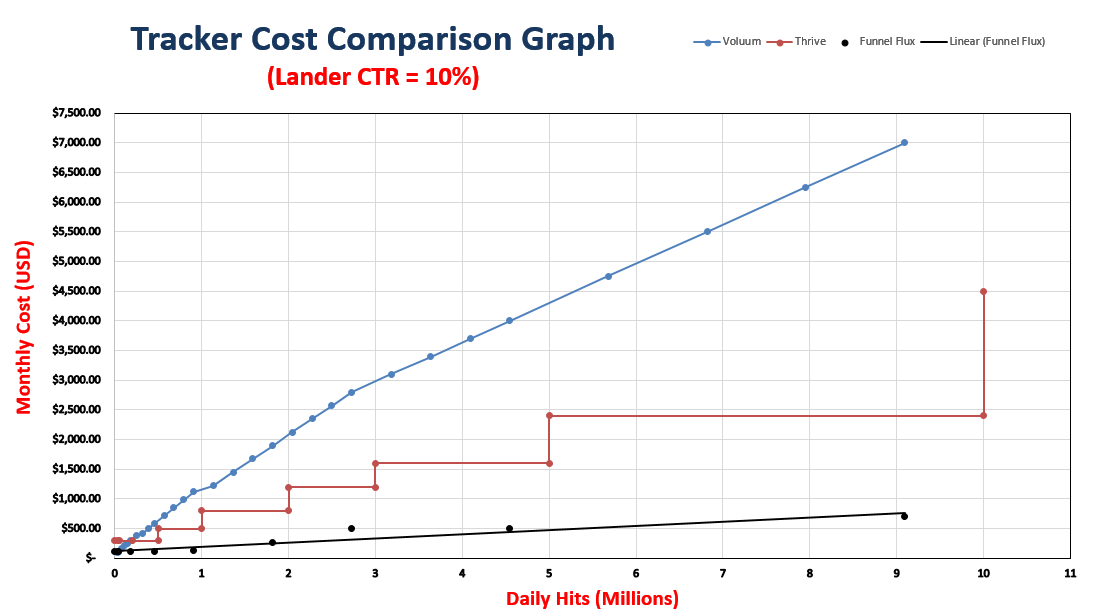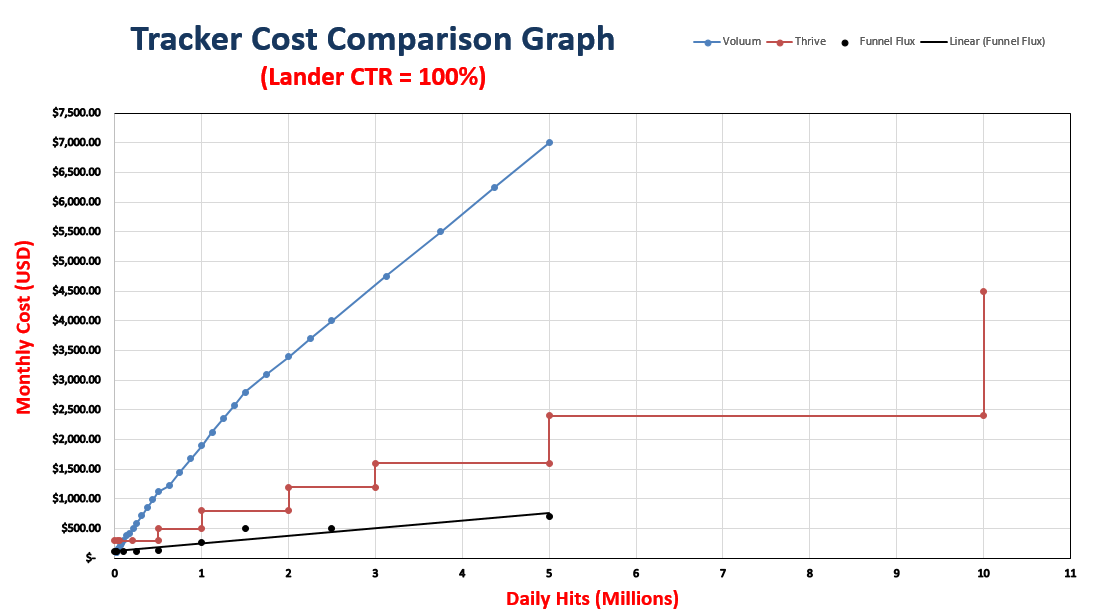Since the earlier poll on "best tracker 2016" attracted so much attention, we thought it would be useful to show a comparison of the top 3 favorite trackers according to poll results.
In case you didn't bother checking out the poll, the top 3 trackers were: Voluum, Thrive, and FunnelFlux.
Unfortunately like many affiliate software tools, it can be difficult to determine exactly how much each tracker will end up costing you.
If you're trying to decide on which tracker to use, I'm assuming cost will be a major consideration. Of course there are others such as tracker features, ease of use etc.
However, this post is designed to demystify the pricing structure of this essential software. It will compare the 3 trackers purely from the economical standpoint - to calculate some estimated costs based on some assumptions of your current (and future) traffic levels.
"Hits" or "Events" Defined
Before doing anything else, let's define what "hits" are, because that is the main metric that determines tracking costs.
Basically, a "hit" is anything that results in data being logged in the tracker - when a banner is clicked, when a pop lander is displayed, when a lander is clicked through, or when a conversion is posted to the tracker from the affiliate network or offer advertiser.
For self-hosted trackers, more hits means you need a more powerful server. For managed trackers, the cost is calculated based on the number of hits as well.
Voluum charges by the number of "events", which is practically the same thing as hits. One interesting point about Voluum is that it does not count “events” from its sister company Zeropark as chargeable hits, so if you are running mainly Zeropark traffic, Voluum can be a very cost effective option.
Thrive charges by initial hits only. This is important, since it will only count banner clicks for display traffic, or lander impressions for pop traffic. No matter how many lander click-throughs or conversions you have, prices are based only on initial hits.
FunnelFlux’s software costs is a flat $99 per month. However, Funnelflux is a self-hosted solution, which means that you are responsible for your own hosting. Your hosting costs will necessarily increase with the number of hits as well: the higher your traffic volume, the more powerful your hosting will need to be, which will result in higher additional costs.
Tracker Plans & Costs
Voluum
Voluum is a fully hosted and managed tracking solution, and has the following plans and corresponding costs:
PRO - $99/month. Includes 1 million hits. Hits over that cost $0.04 per 1000.
AGENCY - $399/month. Includes 10 million hits. Extra hits cost $0.036 per 1000.
ENTERPRISE - $999/month. Includes 30 million hits. Extra hits cost $0.03 per 1000.
You can find Voluum's monthly cost calculator here (scroll to the bottom).
Thrive Managed
$299/mo - up to 200k hits/day
$499/mo - 500k hits/day
$799/mo - 1M hits/day
$1,199/mo - 2M hits/day
$1,599/mo - 3M hits/day
$2,399/mo - 5M hits/day
$4,499/mo - 10M hits/day
Note: Thrive charges by initial hits only - lander clicks and conversions are free.
(Prices are for reference only - subject to change at any time.)
FunnelFlux:
$99/month per license for single domain.
However, since FunnelFlux is a self hosted solution, you will need to factor in additional hosting costs.
We have estimated the additional costs required for hosting based on higher traffic levels which results in total costs including license+hosting of approximately:
~$119/mo (including ~$20/mo for hosting) - up to 500k hits/day
~$139/mo (including ~$40/mo for hosting) - 1M hits/day
~$259/mo (including ~$160/mo for hosting) - 2M hits/day
~$499/mo (including ~$400/mo for hosting) - 5M hits/day
~$699/mo (including ~$600/mo for hosting) - 10M hits/day
(Note: "~" signifies approximate costs. Please see post below for details concerning the tests we have run to arrive at these prices.)
Tracker Costs Comparison Graphs
Here comes the interesting part - Hits vs. Cost graphs for the 3 tracking solutions.
Because Voluum charges by "events", Thrive charges by initial clicks/visits, and FunnelFlux server costs depend on the number of hits, the only way to compare apples to apples would be to calculate costs for each tracker based on certain Lander CTRs.
What do I mean by that? Allow me to take the first set of data points from the graphs, and explain what all the numbers mean:
In this table, "Initial Hits" are either banner clicks if running display traffic, or lander visits if running pop traffic.
Voluum's PRO Plan of $99/month includes 1M events per month. How much traffic or "Initial Hits" can you send to the tracker without going over 1M events?
If you're direct-linking without using a landing page, the $99/mo plan will cover you for 1M "Initial Hits", which are banner clicks for display or offer page views for pop. 1M hits/mo = 33k hits/day.
If you're using a lander, the 1M events will include "Initial Hits" plus the number of lander click-throughs. For example if your average Lander CTR is 10%, that means you can only send 1M/1.1 = 909,090 "Initial Hits" to the tracker to still be covered by the $99/mo plan. 909,090 hits/mo = around 30k/day.
Similarly, the graphs will show you the number of "Initial Hits" you can send to each tracker for the costs shown, for 2 other Lander CTRs: 50% and 100%.
These scenarios are provided to give you an idea on how lander CTR will affect tracker pricing.
(Note: Normally, the number of conversions are included as "events", but because they are usually negligibly low compared to initial hits or lander clicks, they are excluded for ease of calculation.)
We have extended this analysis based on the same set of assumptions from initial 33,000 hits per day all the way to 10,000,000 hits per day. the traffic assumptions all the way to 10 million hits per day.
Finally - below are the Tracker Cost Comparison Graphs under this common set of assumptions.
(Note regarding Voluum data in the graphs above: The Voluum Cost Calculator only goes up to 100M events/month, or 3.33M events/day - which costs $3099/month. All costs beyond this level are extrapolated based on known data.)
Important Considerations
While this analysis may seem to suggest that a self-hosted flat license fee solution is the most cost effective after a certain threshold, it is important to remember that with self-hosted trackers such as FunnelFlux, at high volumes your data storage costs will also become increasingly demanding.
If you want to keep a huge amount of data on a server and run regular reporting on increasingly massive dataset, you need the resources and additional budget for that. Otherwise, you will need to purge data regularly or backup off-site.
Tom Fang from Thrive has wisely pointed out that “Scaling a database is no simple task by itself [...] when your database drive is 500GB and need to scale to 1TB, do not think that it will be an easy task to just ask your hosting provider to increase your drive size [...] this is a huge undertaking the more clicks you have.”
With non-managed infrastructure that does not auto-scale, you should invest in a technical staff member who knows how to handle things. There's no point sending 10 M / day clicks to a server you set up blindly and have no idea what to do with.
These tests do not take into account tracking performance (latencies and redirect speeds), those will depend on your server, its location, and your traffic, as well as load balancing of the system.
When choosing a tracker, pricing should not be the only consideration. Always going for the cheapest option can be a false economy.
Other important considerations are tracker performance (i.e. redirection speed, report generation speed), ease of maintenance (of database for example), and whether the tracker contains the features you're needing.
That's all for this article. Any questions? Fire away!






